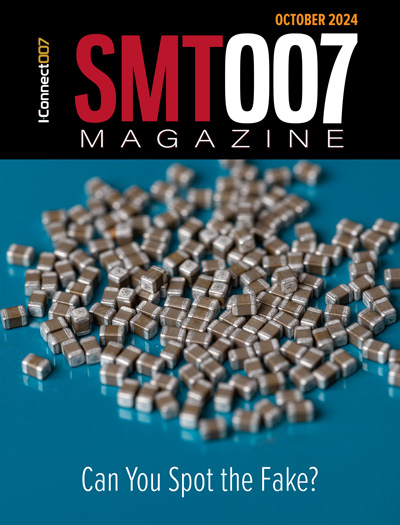-

- News
- Books
Featured Books
- smt007 Magazine
Latest Issues
Current Issue
The Rise of Data
Analytics is a given in this industry, but the threshold is changing. If you think you're too small to invest in analytics, you may need to reconsider. So how do you do analytics better? What are the new tools, and how do you get started?

Counterfeit Concerns
The distribution of counterfeit parts has become much more sophisticated in the past decade, and there's no reason to believe that trend is going to be stopping any time soon. What might crop up in the near future?

Solder Printing
In this issue, we turn a discerning eye to solder paste printing. As apertures shrink, and the requirement for multiple thicknesses of paste on the same board becomes more commonplace, consistently and accurately applying paste becomes ever more challenging.
- Articles
- Columns
Search Console
- Links
- Media kit
||| MENU - smt007 Magazine
Optimizing mSAP to Produce Flex for Biofluid Sensor Probes
October 17, 2024 | Dean Neuburger, Sheldahl Flexible TechnologiesEstimated reading time: 1 minute
Improvements in flexible printed circuitry technology offer solutions that enable advancement in other technologies, enabling new circuit design and capability possibilities for customers’ applications. This article will overview advancements developed and implemented to produce a flexible circuit that meets new and challenging requirements for a customer’s medical application. This discussion will highlight development ideas more than details about the final processing scheme.
The medical application was a sensor designed to be inserted in a body to monitor activity of fluids by measuring minute electrical inflections. Good circuit performance required circuit production that achieves specific geometric precision of small circuit features with net ends far apart. Feature dimensions of the circuit design were approximately 75 µmdistance in one of the axes combined with overall length of approximately half a meter between net ends on opposite layers for circuit components and connector terminations.
An additional requirement was that the base material needed to be very thin to physically fit within the medical device. The material choice was Novaclad diclad, which is adhesiveless and available with 25 µm polyimide film, a very thin and flexible construction—appealing to the customer for functioning well in their application. The processing technique needed to be modified semi-additive processing (mSAP).
To read this entire article, which appeared in the October 2024 issue of Design007 Magazine, click here.
Suggested Items
The Knowledge Base: The Impact of Harsh Environments on Residue Tolerance
11/26/2024 | Mike Konrad -- Column: The Knowledge BaseElectronic devices are ubiquitous, performing critical functions in a wide range of applications, from consumer electronics to aerospace, medical devices, automotive systems, and industrial control systems. Many of these devices operate in harsh environments characterized by extremes in temperature, humidity, pollution, and chemical exposure.
Flexible Thinking: Rules of Thumb—A Word to the Wise
11/20/2024 | Joe Fjelstad -- Column: Flexible ThinkingIn the early days of electronics manufacturing—especially with PCBs—there were no rules. Engineers, scientists, and technicians largely felt their way around in the dark, making things up as they went along. There was a great deal of innovation, guessing, and testing to make sure that early guidelines and estimates were correct by testing them. Still, they frequently made mistakes.
All Flex Solutions Adds Talent to Flexible Circuit Facilities
11/14/2024 | All Flex SolutionsAll Flex Solutions is excited to welcome John Letourneau as our Director of Facilities and Maintenance at our Flexible Circuit Centers of Excellence!
BOOK EXCERPT: The Printed Circuit Designer’s Guide to... DFM Essentials, Chapter 2
11/14/2024 | I-Connect007 Editorial TeamThe guidelines offered in this book are based on both ASC recommendations and IPC standards with the understanding that some may require adjustment based on the material set, fabricator processes, and other design constraints. This chapter discusses panelization, placing PCBs on manufacturing panels, highlighting features like coupons, borders, and scoring to maximize material utilization and reduce costs, and detailing preferred panel sizes and modifications.
Flexible Circuit Technologies Announces Major Expansion of Capabilities & Resources
11/13/2024 | CNWFlexible Circuit Technologies (FCT), a global design and value add manufacturer of flexible circuits, heaters, and membrane switches based in Minneapolis, MN, announces the opening of FCT-Huizhou.


